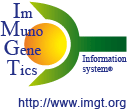
More in...
The Immunoglobulin FactsBook
DNA
Overview
The human IGK locus is located on the
chromosome 2 [1],
on the short arm, at band 2p11.2 [2].
The list of human IGK genes is available at
IMGT/GENE-DB.
Human IGK locus at 2p11.2
- The human IGK locus at 2p11.2 spans 1820 kilobases (kb). The orientation of the locus has been determined by the analysis of translocations, involving the IGK locus, in leukemia and lymphoma.
- The human IGK locus consists of 76 IGKV genes [3-10] belonging to 7 subgroups, 5 IGKJ segments [9-11], and a unique IGKC gene [12]. The 76 IGKV genes are organized in two clusters separated by 800 kb. The IGKV distal cluster (in 5' of the locus and in the most centromeric position) spans 400 kb and comprises 36 genes. The IGKV proximal cluster (in 3' of the locus, closer to IGKC, and in the most telomeric position) spans 600 kb and comprises 40 genes.
- The potential genomic IGK repertoire comprises 31 to 36 functional IGKV genes belonging to 5 subgroups, the 5 IGKJ segments, and the unique IGKC gene. One rare IGKV haplotype has been described which contains only the proximal cluster. This haplotype comprises the 40 proximal IGKV genes belonging to 7 subgroups, of which 17 to 20 are functional and belong to 5 subgroups [13,14].
Orphons
Twenty-five IGKV orphons have been identified and sequenced corresponding to 5 chromosomal orphon sets: two on the short arm of chromosome 2 but outside of the main IGK locus, 12 on the long arm of chromosome 2, 5 on chromosome 22, one on chromosome 1, one on chromosome 15, and 4 outside of chromosome 2 [9].
Total number of human IGK genes
If both the proximal and distal IGKV clusters are present, the total number of human IGK genes per haploid genome is 82 (107 genes, if the orphons are included) of which 37-42 are functional [14]. If only the proximal IGKV cluster is present, the total number of genes per haploid genome is 46 (71 genes, if the orphons are included) of which 23-26 genes are functional.
IG and TR number of genes: Human
Nomenclature and overview
of the human immunoglobulin genes (IMGT Education)
Nomenclature
IGKV gene nomenclature
- Human IGKV genes are designated by a number for the subgroup, followed by a hyphen and a number for the localization from 3' to 5' in the locus [15,16].
- The IGKV genes of the distal duplicated V-CLUSTER are designated by the same number as the corresponding genes in the proximal V-CLUSTER, with the letter D added.
IMGT and HUGO gene nomenclatures
- IMGT gene names have been approved by the Human Genome Organization (HUGO) Nomenclature Committee in 1999. All the IGK gene names (symbols) are identical in IMGT and HUGO nomenclatures.
- IGK gene definitions (full names) are identical in IMGT and HUGO nomenclatures.
Links between IMGT and Entrez Gene
The complete list of the human immunoglobulin and T cell receptor IMGT gene names (symbols) provides the IMGT definition (full name), the gene functionality, the IMGT accession number of the reference sequence, the number of alleles per gene, and Entrez Gene accession ID. The table below reports entries which concern the IGK locus or groups and are found in the OMIM and Entrez Gene genome databases, and in HUGO:
| IMGT name | IMGT definition (a) | OMIM | Entrez Gene | HUGO |
|---|---|---|---|---|
| IGK locus | Immunoglobulin kappa locus | - | - | IGK@ |
| IGKJ group | Immunoglobulin kappa joining group | 146970 | 7842 | IGKJ@ |
| IGKV group | Immunoglobulin kappa variable group | 146980 | 3519 | IGKV@ |
(a) The locus definition is identical in IMGT, Entrez Gene and HUGO. The IMGT 'group' concept comprises genes of the major locus and of the chromosomal orphon sets, whereas the HUGO IG group symbols only refer to genes of the major locus.
Protein
Proteins encoded by the IGK locus are the immunoglobulin kappa chains. They result from the recombination (or rearrangement), at the DNA level, of two genes: IGKV and IGKJ, with deletion of the intermediary DNA to create a rearranged IGKV-J gene. The rearranged IGKV-J gene is transcribed with the IGKC gene and translated into an immunoglobulin kappa chain. Translation of the variable germline genes involved in the IGKV-J rearrangements are available at Protein displays. Compared to the germline genes, the rearranged variable genes will acquire somatic mutations during the B cell differentiation in the lymph nodes, which will considerably increase their diversity. These somatic mutations can be analysed using the IMGT/V-QUEST tool. The junctions can be analysed with IMGT/JunctionAnalysis.
Alleles and mutations
Mutations which correspond to allelic polymorphisms of the functional germline IGKV, IGKJ and IGKC genes are described in Alignments of alleles [14] and Tables of alleles.
Translocations
Translocations in which the human IGK locus is implicated frequently result from errors of the recombinase enzyme complexe (RAG1, RAG2, ...), which is responsable of the Immunoglobulin and T cell receptor V-J and V-D-J rearrangements. IGKV or IGKJ recombination signals or isolated heptamer are observed at the breakpoints.
t(2;8)(p12;q24)
t(2;3)(p12;q27)
| [1] | Malcolm, S., Barton, P., Murphy, C., Ferguson-Smith, M.A., Bentley, D.L. and Rabbitts, T.H. "Localization of human immunoglobulin kappa light chain variable region genes to the short arm of chromosome 2 by in situ hybridization" Proc. Natl. Acad. Sci. USA, 79, 4957-4961 (1982) PMID: 83015011 |
| [2] | Mc Bride, O.W., Hieter, P.A., Hollis, G.F., Swan, D., Otey, M.C. and Leder, P. "Chromosomal location of human kappa and lambda immunoglobulin light chain constant region genes" J. Exp. Med., 155, 1480-1490 (1982) PMID: 82169267 |
| [3] | Zachau, H.G. "The immunoglobulin kappa locus-or-what has been learned from looking closely at one-tenth of a percent of the human genome" Gene, 135, 167-173 (1993) PMID: 94102555 |
| [4] | Zachau, H.G., The Immunologist, 4, 49-54 (1996). |
| [5] | Huber, C., Huber, E., Lautner-Rieske, A., Schable, K.F. and Zachau, H.G "The human immunoglobulin kappa locus. Characterization of the partially duplicated L regions" Eur. J. Immunol., 23, 2860-2867 (1993) PMID: 94039385 |
| [6] | Schable, K.F. and Zachau, H.G. "The variable genes of the human immunoglobulin kappa locus" Biol. Chem. Hoppe-Seyler, 374, 1001-1022 (1993) PMID: 94121783 |
| [7] | Cox, J.P., Tomlinson, I.M. and Winter, G. "A directory of human germ-line V kappa segments reveals a strong bias in their usage" Eur. J. Immunol., 24, 827-836 (1994) PMID: 94200218 |
| [8] | Schable, K.F., Thiebe, R., Flugel, A., Meindl, A. and Zachau, H.G. "The human immunoglobulin kappa locus: pseudogenes, unique and repetitive sequences" Biol. Chem. Hoppe-Seyler, 375, 189-199 (1994) PMID: 94280631 |
| [9] |
Barbié, V. and Lefranc, M.-P.
"IMGT Locus on Focus:
The human immunoglobulin kappa variable (IGKV) genes and joining (IGKJ) segments"
Exp. Clin. Immunogenet., 15, 171-183 (1998) PMID: 9813414
|
| [10] |
Scaviner, D., Barbié, V., Ruiz, M. and Lefranc, M.-P.
"IMGT Locus on Focus:
Protein displays of the human immunoglobulin heavy, kappa and lambda variable and joining regions"
Exp. Clin. Immunogenet., 16, 234-240 (1999) PMID: 10575277
|
| [11] | Hieter, P.A., Maizel, J.V. Jr. and Leder, P. "Evolution of human immunoglobulin kappa J region genes" J. Biol. Chem., 257, 1516-1522 (1982) PMID: 82120090 |
| [12] | Hieter, P.A., Max, E.E., Seidman, J.G., Maizel, J.V. Jr. and Leder, P. "Cloned human and mouse kappa immunoglobulin constant and J region genes conserve homology in functional segments" Cell, 22, 197-207 (1980) PMID: 81042304 |
| [13] | Lefranc, M.-P. "Locus maps and genomic repertoire of the human Ig genes" The Immunologist, 3, 80-87 (2000) |
| [14] | Lefranc, M.-P. and Lefranc, G., "The immunoglobulin Factsbook" Academic Press, Hartcourt Publishers Limited, London, UK, 458 pages (2001) ISBN:012441351X |
| [15] | Lefranc, M.-P. "Nomenclature of the human immunoglobulin genes" Curr. Prot. Immunol., A.1P.1-A.1P.37 (2000) |
| [16] |
Lefranc, M.-P. "IMGT Locus in Focus:
Nomenclature of the human immunoglobulin kappa (IGK) genes", Exp. Clin. Immunogenet., 18, 161-174 (2001).
PMID: 11549845
|



